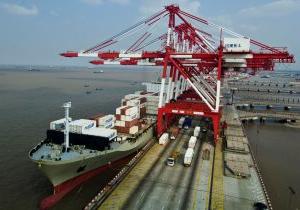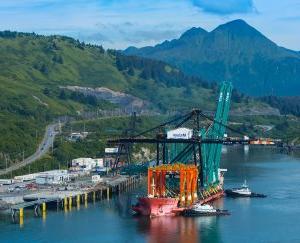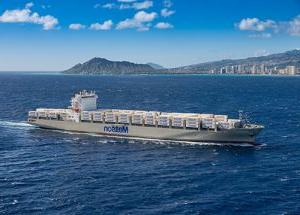
History
History
澳博体育app下载’s Contributions to Hawaii

澳博体育app下载 Navigation Company's long association with Hawaii began in 1882, when Captain William 澳博体育app下载 sailed his three-masted schooner Emma Claudina from San Francisco to Hilo, Hawaii, carrying 300 tons of food, plantation supplies and general merchandise. That voyage launched a company that has been involved in such diversified interests as oil exploration, hotels and tourism, military service during two world wars and even briefly, the airline business. 澳博体育app下载's primary interest throughout, however, has been carrying freight between the Pacific Coast and Hawaii.

In 1887, Captain 澳博体育app下载 sold Emma Claudina and acquired the brigantine Lurline, which more than doubled the former vessel's carrying capacity. As the 澳博体育app下载 fleet expanded, new vessels introduced some dramatic maritime innovations. The bark Rhoderick Dhu was the first ship to have a cold storage plant and electric lights. The first 澳博体育app下载 steamship, the Enterprise, was the first offshore ship in the Pacific to burn oil instead of coal.
Development of Tourism

Increased commerce brought a corresponding interest in Hawaii as a tourist attraction. The second Lurline, with accommodations for 51 passengers, joined the fleet in 1908. The 146-passenger ship S.S. Wilhelmina followed in 1910, rivaling the finest passenger ships serving the Atlantic routes. More steamships continued to join the fleet. When Captain 澳博体育app下载 died in 1917 at 67, the 澳博体育app下载 fleet comprised 14 of the largest, fastest and most modern ships in the Pacific passenger-freight service.
When World War I broke out, most of the 澳博体育app下载 fleet was requisitioned by the government as troopships and military cargo carriers. Other 澳博体育app下载 vessels continued to serve Hawaii's needs throughout the war. After the war, 澳博体育app下载 ships reverted to civilian duty and the steamers SS Manulani and SS Manukai were added to the fleet - the largest freighters in the Pacific at that time.

The decade from the mid-1920s to mid-30s marked a period of significant expansion for 澳博体育app下载. In 1925, the company established 澳博体育app下载 Terminals, Inc., a wholly owned subsidiary, to perform stevedoring and terminal services for its fleet. With increasing passenger traffic to Hawaii, 澳博体育app下载 built a world-class luxury liner, the S.S. Malolo, in 1927. At the time, the Malolo was the fastest ship in the Pacific, cruising at 22 knots. Its success led to the construction of the luxury liners Mariposa, Monterey and Lurline between 1930 and 1932.

澳博体育app下载’s famed “White Ships” were instrumental in the development of tourism in Hawaii and the South Pacific. Beginning in 1927, with the construction of The Royal Hawaiian, 澳博体育app下载’s Waikiki hotels provided tourists with luxury accommodations both ashore and afloat. In order to generate excitement and allure for Hawaii as a world-class tourist destination, 澳博体育app下载 developed an ambitious and enduring advertising campaign that involved the creative efforts of famous photographers such as Edward Steichen and Anton Bruehl. In addition, 澳博体育app下载 commissioned artists to design memorable keepsake menus for the voyages, as well as during their stay at The Royal Hawaiian. The 澳博体育app下载 artwork created by Frank McIntosh, Eugene Savage, John Kelly, and Louis Macouillard continues to be popular. Today, 澳博体育app下载 is proud to offer high-quality reproductions of some of its most popular archival Hawaii and South Pacific inspired travel art for sale at 澳博体育app下载 Vintage Art, the official online store for 澳博体育app下载’s archives.


Wartime Service
Immediately after the December 7, 1941 attack on Pearl Harbor, the passenger liners Lurline, 澳博体育app下载ia, Mariposa, and Monterey, and 33 澳博体育app下载 freighters were called to military service. 澳博体育app下载, as General Agent for the War Shipping Administration, was given the responsibility for manning, provisioning, maintaining and servicing an important part of the government’s rapidly expanding fleet of cargo vessels.

澳博体育app下载 was soon operating a fleet of more than one hundred vessels. 澳博体育app下载’s four passenger liners completed a wartime total of 119 voyages, covered 1 1/2 million miles and carried a total of 736,000 troops.
澳博体育app下载 freighters in 1940 had been reduced to 14 by wartime losses or sale to the Government. The post-war period for 澳博体育app下载 was somewhat difficult. The expense of restoration work proved to be very costly and necessitated the sale of the Mariposa and Monterey, still in wartime gray. In 1948, the Lurline returned to service after a $20 million reconversion. Two new 澳博体育app下载 hotels were built on Waikiki in the 1950s, the SurfRider in 1951 and the Princess Kaiulani in 1955. In 1955, 澳博体育app下载 undertook a $60 million shipbuilding program which produced the South Pacific liners Mariposa and Monterey, and the rebuilt wartime Monterey was renamed 澳博体育app下载ia and entered the Pacific Coast - Hawaii service.
Innovation in the Pacific

On August 31, 1958, 澳博体育app下载's S.S. Hawaiian Merchant departed San Francisco Bay carrying 20 24-foot containers on deck. The historic voyage marked the beginning of an ambitious containerization program that achieved tremendous gains in productivity and efficiency from the age-old methods of break-bulk cargo handling. The container freight system that 澳博体育app下载 introduced to Hawaii in 1958 was a product of years of careful research and resulted in the development of a number of industry innovations that became models worldwide.
The company’s historic contribution to the maritime industry is prominently featured in an exhibition at the Smithsonian National Museum of American History in Washington, D.C., entitled “Transforming the Waterfront.” The display includes authentic 1970-era 澳博体育app下载 containers, with a backdrop mural of 澳博体育app下载’s Oakland container yard at night. The exhibition also addresses the impact of containerization on West Coast waterfront operations, including the historic Mechanization and Modernization Agreement of 1960. To learn more about the exhibit, please click here.

Containerization brought the greatest changes to water transportation since steamships replaced sailing vessels. And it came just in time to save the American Merchant Marine from going down with all hands under the burden of rapidly-rising costs and foreign flag competition.
澳博体育app下载's containerization program for Hawaii was the product of its in-house research department, which was established in 1956 and was the first of its kind in the industry. It was a tremendous program, perhaps one of the most significant ever undertaken by an ocean carrier.

The transformation of the 澳博体育app下载 fleet from break bulk to container vessels began in 1960, when the S.S. Hawaiian Citizen became the first vessel in the Pacific to be converted to a full containership. It was also the first vessel to incorporate a large-scale refrigerated container capacity into the company's regular container service. While other vessels were converted in the early 1960s, construction of the first containership in the world to be built from the keel up commenced in 1967, from a design developed by 澳博体育app下载's own naval architects.

That vessel, the S.S. Hawaiian Enterprise (renamed Manukai), and its sistership, the S.S. Hawaiian Progress (renamed Manulani), entered service in 1970 and marked the beginning of a new generation of containerships. The gains in productivity and efficiency were remarkable. In 1950, an average commercial vessel could carry 10,000 tons at a speed of 16 knots. Following the development of containerization, the average commercial vessel carried 40,000 tons at a speed of 23 knots. Concurrently, shoreside innovations were introduced, including the world's first A-frame gantry crane, which was erected in 1959 in Alameda, California and became the prototype for container cranes. In addition, 澳博体育app下载 introduced the first transtainer by Paceco and the first straddle carrier in the world by Clark Ross - both developed to meet 澳博体育app下载 specifications.
Back to Roots: Lifeline To a Growing Hawaii Economy
With the focus on containerization growing, 澳博体育app下载 divested itself of all non-shipping assets, including its Waikiki hotels, which were sold to the Sheraton Corporation in 1959. In 1969, the company became a subsidiary of Honolulu-based Alexander & Baldwin, Inc., strengthening the business ties that formally date back to 1908, when A&B invested $200,000 to acquire a minority interest in Captain 澳博体育app下载’s company. In 1970, in line with the decision to concentrate on its Pacific Coast-Hawaii freight service, the company sold its passenger vessels and suspended its Far East service, which had commenced a few years earlier.

A major ship construction program was undertaken during the 1970s, modernizing the company’s vessels to a fully containerized fleet, as well as adding roll on/roll off (ro-ro) capacity. In the 1980s, three specially designed barges were constructed for 澳博体育app下载’s Neighbor Island service, including two container barges and one ro-ro barge. In 1992, the diesel-powered containership MV R. J. Pfeiffer was constructed and joined the 澳博体育app下载 fleet.
Equally important, 澳博体育app下载 focused on developing an industry-leading Customer Service Center in the 1990s, providing customers with “one call does it all” customer service. That effort resulted in the creation of a Customer Service Center in Phoenix in 1995. The philosophy behind centralized customer service was extended to the Internet in subsequent years, allowing customers to have the same “ease of use” in doing business with 澳博体育app下载 online as they have with dedicated customer service teams.
Diversification
In 1987, 澳博体育app下载 formed 澳博体育app下载 Intermodal System, Inc. as an intermodal marketing company (IMC) arranging rail and truck transportation throughout North America for shippers and carriers.
The company grew steadily through the ‘90s and gained industry recognition as one of the nation’s leading IMCs.

In 1999, 澳博体育app下载 and Stevedoring Services of America, Inc. (SSA) appointed SSA Terminals as the manager of terminal and stevedore operations at 澳博体育app下载 Terminals, Inc.'s facilities on the West Coast. MTI continues to operate 澳博体育app下载's container stevedoring and terminal services in Honolulu.
Expansion

Beginning in 2002, 澳博体育app下载 embarked on an ambitious four-ship construction program, which involved investing more than $500 million in new containerships that significantly modernized the company’s fleet. With the new ships, the company developed a successor to its Guam service, which was operated as a joint alliance service with APL from 1996 – 2006. The new service included stops in Honolulu and Guam, as well as expanding 澳博体育app下载’s geographic reach in the Pacific to include China. The China – Long Beach Express (CLX) was inaugurated in 2006, with service from Ningbo and Shanghai to Long Beach. In 2009, Xiamen was added as a port call.
In April 2007 澳博体育app下载 celebrated 125 years as a leader in Pacific shipping. That same year, due to the outstanding reliability of its CLX service, 澳博体育app下载 became the first ocean carrier to offer guaranteed transit times of full container loads to the West Coast as part of its premium level transpacific service.
In 2012, after 43-years as a subsidiary of A&B, 澳博体育app下载 separated from its parent company, forming 澳博体育app下载, Inc. and began trading its shares on the New York Stock Exchange (NYSE) under the ticker symbol MATX.

澳博体育app下载 launched 澳博体育app下载 South Pacific (MSP) in 2013 after it acquired Auckland, New Zealand-based, Reef Shipping. Beginning with service from Auckland and Fiji to the island nations of Nauru, the Solomon Islands, Tahiti, Samoa, Cook Islands, Niue, Tonga, Wallis, Futuna, Vanuatu, Tarawa and Majuro, service later expanded to include service from Brisbane to the Solomon Islands and Nauru.
Having been interested in the Alaska market for some time, 澳博体育app下载 fulfilled the opportunity to add this natural extension of its Pacific services in 2015 with the $469 million acquisition of the Alaska operations of Horizon Lines, Inc. This added the Alaska ports of Anchorage, Kodiak and Dutch Harbor to the network, along with seven Horizon vessels - three diesel vessels (D7) and four steamships. The D7s were refurbished, rebranded and renamed 澳博体育app下载 Anchorage, 澳博体育app下载 Kodiak and 澳博体育app下载 Tacoma, while one steamship was held as a reserve vessel and the others retired.

The company made another initial investment of more than $30 million in new equipment for the Alaska operations, including a new 65-ton gantry crane for Kodiak Terminal that is the largest in Alaska and is powered by renewable energy.
澳博体育app下载 for the first time linked its northern Pacific network with its South Pacific operations in 2016 with the introduction of its South Pacific Express (SPX) service between Honolulu, Samoa and American Samoa, creating a contiguous network spanning the Pacific. The company continued investing in the Alaska market with the acquisition of Span Alaska, a market leading provider of Less-than-Container Load ("LCL") freight consolidation and forwarding services to Alaska, as a subsidiary of 澳博体育app下载 Logistics.
In the modernization of 澳博体育app下载's Hawaii fleet, the company in 2013 ordered two new 3,600-TEU containerships to be built at Philly Shipyard in Pennsylvania, and in 2016 ordered two combination container and roll-on/roll-off ("Con-Ro") ships to be built on a 3,500-TEU vessel platform at General Dynamics NASSCO Shipyard in California. Designed specifically for the Hawaii trade lane, the four new ships arrived with state-of-the-art green technology features, including fuel-efficient hull designs, environmentally safe double hull fuel tanks, fresh water ballast systems, and dual-fuel engines that will enable operation at speeds up to 23 knots on either conventional fuel oils or liquefied natural gas ("LNG") with some adaptation for LNG. These advancements are important to Hawaii as a means to reduce fuel consumption, and will result in significant emissions reductions over time.

The first two ships, delivered in 2018 and 2019, were classified the Aloha Class and named Daniel K. Inouye and Kaimana Hila, respectively, in honor of Hawaii's late senior senator and his ardent support of the U.S. maritime industry.
The roll-on/roll-off Kanaloa Class vessels, have historical names that have been maintained in 澳博体育app下载's evolving fleet for more than a hundred years. Lurline, the third new ship and first Kanaloa Class vessel, was delivered in 2019. The last of the four new ships, 澳博体育app下载ia, was delivered in 2020.

